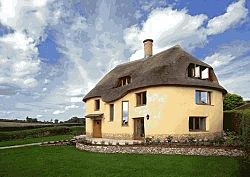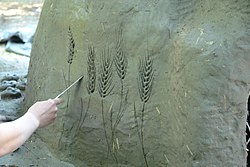Cob (material)


Cob, or clom in Wales, is a natural building material.[1]
Cob is made from "subsoil" (soil below the top layer), water, some kind of fibrous organic material (usually straw), and sometimes lime. The contents of subsoil varies and if it does not contain the right mixture is can be modified with sand or clay. Cob is fireproof, resists seismic activity,[2] and inexpensive. It can be used to create artistic, sculptural forms and has been revived in recent years by the natural building and sustainability movements.
Cob material is known by many names including adobe,[3] lump clay,[3] puddled clay, chalk mud,[3] wichert,[3] clay daubins,[3] swish (African), torchis (French),[4] bauge (French),[4] bousille (French mud with moss).[4]
The material has a long life-span even in rainy climates, provided a tall foundation and large roof overhang are present.
Cob (material) Media
Maison de Jeanne, Sévérac-le-Château. Timber and cob construction
The Sota Construction Services Corporate Headquarters in Pittsburgh, Pennsylvania, United States, constructed of cob walls
References
- ↑ Wright, Joseph. 1898. "COB(B, sb3. 1.", The English dialect dictionary, being the complete vocabulary of all dialect words still in use, or known to have been in use during the last two hundred years. London: H. Frowde, 676-677.
- ↑ Goodnow, Cecelia (October 5, 2007). Thinking of building a cob home?. http://www.seattlepi.com/lifestyle/article/Thinking-of-building-a-cob-home-1251753.php.
- ↑ 3.0 3.1 3.2 3.3 3.4 Rapp, George Robert. "Unbaked clay or mud", Archaeomineralogy. 2nd ed. Berlin: Springer, 2009. Print.
- ↑ 4.0 4.1 4.2 Edwards, Jay Dearborn, and Nicolas Verton. "mud with straw", A Creole Lexicon Architecture, Landscape, People. Baton Rouge: Louisiana State UP, 2004. Print.




